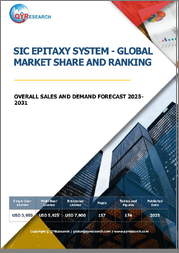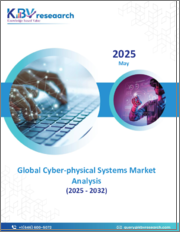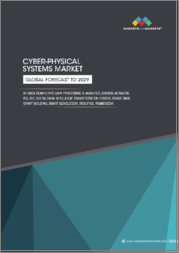
|
시장보고서
상품코드
1811929
사이버 물리 시스템(CPS) 시장 : 세계 산업 분석, 규모, 점유율, 성장, 동향, 예측(2024-2031년)Cyber-Physical Systems (CPS) Market: Global Industry Analysis, Size, Share, Growth, Trends, and Forecast, 2024 - 2031 |
||||||
Persistence Market Research는 최근 사이버 물리 시스템(CPS) 세계 시장에 대한 종합 보고서를 발표했습니다. 이 보고서는 시장 성장 촉진요인, 동향, 기회, 과제 등 중요한 시장 역학을 철저히 평가하고 시장 구조에 대한 상세한 통찰력을 제공합니다. 이 조사 보고서는 2024년부터 2031년까지 세계 사이버 물리 시스템 시장 예측 성장 궤적을 개괄하는 독점 데이터와 통계를 제공합니다.
주요 인사이트
- 사이버 물리 시스템 시장 규모(2024E) : 1,112억 1,000만 달러
- 예측 시장 규모(2031F) : 2,770억 1,000만 달러
- 세계 시장 성장률(CAGR 2024-2031년) : 13.9%
사이버 물리 시스템 시장 - 조사 범위:
사이버 물리 시스템은 계산, 네트워킹, 물리적 프로세스의 통합이며, 물리적 구성 요소와 디지털 구성 요소 간의 원활한 상호 작용을 가능하게 합니다. 이러한 시스템은 제조, 의료, 운송, 에너지 등의 분야에서 중요한 역할을 수행하며 혁신과 업무 효율성 향상을 촉진하고 있습니다. CPS 시장은 스마트 팩토리, 자율주행차, 스마트 그리드, 커넥티드 헬스케어 시스템 등 다양한 용도를 포괄하고 있습니다. 시장 성장은 인더스트리 4.0의 채택 증가, IoT 기술의 발전, 실시간 데이터 처리 및 의사 결정에 대한 요구가 증가함에 따라 추진되고 있습니다. 예지보전과 디지털 트윈과 같은 새로운 용도는 산업 전반에 걸쳐 CPS의 관련성을 더욱 높이고 있습니다.
시장 성장 촉진요인:
세계 CPS 시장은 산업 공정의 자동화 및 스마트 솔루션에 대한 수요 증가와 같은 몇 가지 중요한 요인에 의해 주도되고 있습니다. IoT 장치와 센서의 채택으로 데이터 수집이 강화되어 물리적 시스템을 실시간으로 효율적으로 제어할 수 있게 됩니다. 스마트 인프라와 기업의 디지털 혁신을 촉진하는 정부의 이니셔티브는 시장 성장을 더욱 촉진하고 있습니다. 엣지 컴퓨팅, AI, 머신러닝의 기술 발전은 지능형 CPS 솔루션의 개발에 기여하여 기능성과 효율성 향상을 보장합니다. 또한, 다양한 부서에서 중요한 업무를 관리하기 위한 안전하고 탄력적인 시스템의 필요성이 CPS에 대한 수요를 촉진하고 있습니다.
시장 성장 억제요인:
유망한 전망에도 불구하고, CPS 시장은 사이버 보안에 대한 우려, 높은 도입 비용, 다양한 기술 통합의 복잡성 등의 과제에 직면해 있습니다. 네트워크화된 시스템에서 데이터 유출 및 취약점의 위협은 심각한 위험을 초래하기 때문에 강력한 보안 대책이 필요합니다. 또한, CPS 도입에 필요한 초기 투자비용이 높기 때문에 특히 중소기업(SME)의 경우 도입이 쉽지 않을 수 있습니다. 또한, 숙련된 전문가 부족과 레거시 시스템과 최신 CPS 기술 간의 상호운용성 문제가 원활한 통합과 확장성을 저해하고 있습니다. 이러한 문제를 해결하기 위해서는 이해관계자간의 협력, 사이버 보안 솔루션에 대한 투자, 인력 역량 강화가 필요합니다.
시장 기회:
CPS 시장은 기술 혁신, 도시화, 스마트시티 구상의 확대로 인해 큰 성장 기회를 가져오고 있습니다. 인공지능과 머신러닝을 CPS에 통합하면 예측 분석이 가능해져 의사결정과 업무 효율성이 향상됩니다. 또한, 재생 에너지 관리 및 지속 가능한 관행에서 CPS의 채택은 세계 지속가능성 목표에 부합하고 시장 확대의 길을 열어줍니다. 이러한 기회를 활용하기 위해서는 기술 제공업체, 정부, 업계 리더들 간의 협력이 필수적입니다.
본 보고서에서 다룬 주요 질문
- CPS 시장의 세계 성장을 가속하는 주요 요인은?
- 스마트 제조 및 운송 분야의 CPS 용도이 산업 역학에 어떤 영향을 미칠 것인가?
- CPS 시장의 진화를 형성하는 기술 발전은 무엇인가?
- CPS 시장의 주요 기업은 누구이며, 시장 관련성을 유지하기 위해 어떤 전략을 채택하고 있는가?
- 세계 CPS 시장의 새로운 트렌드와 전망은?
목차
제1장 주요 요약
제2장 시장 개요
- 시장 범위와 정의
- 시장 역학
- 성장 촉진요인
- 성장 억제요인
- 기회
- 과제
- 주요 동향
- 거시경제 요인
- 세계의 GDP 성장 전망
- 사이버 보안 위협 상황
- 경제 구도와 IT 예산 배분
- 연구개발에 대한 투자
- 브로드밴드와 5G 보급
- COVID-19의 영향 분석
- 예측 요인 - 관련성과 영향
제3장 부가가치 인사이트
- 규제 상황
- 밸류체인 분석
- PESTLE 분석
- Porter의 Five Forces 분석
제4장 가격 동향 분석
- 주요 하이라이트
- CPS 가격에 영향을 미치는 주요 요인
- 가격 분석
- 구독 분석
- 지각적 라이선스
- 하드웨어 기반 가격 분석
제5장 세계의 CPS 시장 전망 : 과거(2019-2023년)와 예측(2024-2031년)
- 세계의 CPS 시장 전망 : 컴포넌트
- 서론/주요 조사 결과
- 2019-2023년 시장 규모와 컴포넌트별 분석
- 현재 시장 규모와 분석 및 예측, 컴포넌트별, 2024-2031년
- 하드웨어
- 센서
- 액추에이터
- 컴퓨테이셔널 노드
- 기타
- 소프트웨어
- 서비스
- 하드웨어
- 시장 매력 분석 : 구성요소
- 세계의 CPS 시장 전망 : 유형
- 서론/주요 조사 결과
- 2019-2023년 시장 규모 추이 분석(유형별)
- 현재 시장 규모 분석과 예측, 유형별, 2024-2031년
- 오픈 루프
- 클로즈드 루프
- 시장 매력 분석 : 유형
- 세계의 CPS 시장 전망 : 수직
- 서론/주요 조사 결과
- 2019-2023년 업계별 분석(업종별)
- 현재 시장 규모 분석과 예측, 업계별, 2024-2031년
- 헬스케어
- 제조업
- 자동차
- 농업
- 에너지 및 유틸리티
- 항공우주 및 방위
- 기타
- 시장 매력 분석 : 수직
제6장 세계의 CPS 시장 전망 : 지역
- 주요 하이라이트
- 2019-2023년 지역별 시장 규모와 분석
- 현재 시장 규모 분석과 예측, 지역별, 2024-2031년
- 북미
- 유럽
- 동아시아
- 남아시아 및 오세아니아
- 라틴아메리카
- 중동 및 아프리카
- 시장 매력 분석 : 지역
제7장 북미의 CPS 시장 전망 : 과거(2019-2023년) 및 예측(2024-2031년)
제8장 유럽의 CPS 시장 전망 : 과거(2019-2023년) 및 예측(2024-2031년)
제9장 동아시아의 CPS 시장 전망 : 과거(2019-2023년) 및 예측(2024-2031년)
제10장 남아시아 및 오세아니아의 CPS 시장 전망 : 과거(2019-2023년) 및 예측(2024-2031년)
제11장 라틴아메리카의 CPS 시장 전망 : 과거(2019-2023년)와 예측(2024-2031년)
제12장 중동 및 아프리카의 CPS 시장 전망 : 과거(2019-2023년) 및 예측(2024-2031년)
제13장 경쟁 구도
- 시장 점유율 분석, 2025년
- 시장 구조
- 경쟁 강도 매핑
- 경쟁 대시보드
- 기업 개요(상세 - 개요, 재무, 전략, 최근 동향)
- ABB Group
- Siemens AG
- General Electric
- Rockwell Automation
- Honeywell International
- Bosch Rexroth
- Schneider Electric
- Mitsubishi Electric
- Intel Corporation
- Cisco Systems
- Samsung Electronics
- Hitachi, Ltd.
제14장 부록
- 조사 방법
- 조사 전제
- 두자어 및 약어
Persistence Market Research has recently released a comprehensive report on the worldwide market for Cyber-Physical Systems (CPS). The report offers a thorough assessment of crucial market dynamics, including drivers, trends, opportunities, and challenges, providing detailed insights into the market structure. This research publication presents exclusive data and statistics outlining the anticipated growth trajectory of the global Cyber-Physical Systems market from 2024 to 2031.
Key Insights:
- Cyber-Physical Systems Market Size (2024E): US$ 111.21 Bn
- Projected Market Value (2031F):US$ 277.01 Bn
- Global Market Growth Rate (CAGR 2024 to 2031): 13.9%
Cyber-Physical Systems Market - Report Scope:
Cyber-Physical Systems are an integration of computation, networking, and physical processes, enabling seamless interaction between physical and digital components. These systems play a critical role in sectors such as manufacturing, healthcare, transportation, and energy, driving innovation and operational efficiency. The CPS market encompasses diverse applications, including smart factories, autonomous vehicles, smart grids, and connected healthcare systems. Market growth is propelled by the increasing adoption of Industry 4.0, advancements in IoT technologies, and the growing need for real-time data processing and decision-making. Emerging applications, such as predictive maintenance and digital twins, further enhance the relevance of CPS across industries.
Market Growth Drivers:
The global CPS market is driven by several key factors, including the rising demand for automation and smart solutions in industrial processes. The adoption of IoT devices and sensors enhances data collection, enabling efficient control of physical systems in real-time. Government initiatives promoting smart infrastructure and the digital transformation of businesses further support market growth. Technological advancements in edge computing, AI, and machine learning contribute to the development of intelligent CPS solutions, ensuring enhanced functionality and efficiency. Furthermore, the need for secure and resilient systems to manage critical operations across various sectors fosters the demand for CPS.
Market Restraints:
Despite the promising outlook, the CPS market faces challenges, including cybersecurity concerns, high implementation costs, and the complexity of integrating diverse technologies. The threat of data breaches and vulnerabilities in networked systems poses significant risks, necessitating robust security measures. Additionally, the high initial investment required for CPS deployment may deter adoption, particularly among small and medium-sized enterprises (SMEs). Furthermore, a shortage of skilled professionals and interoperability issues between legacy systems and modern CPS technologies hinder seamless integration and scalability. Addressing these challenges requires collaboration among stakeholders, investment in cybersecurity solutions, and workforce upskilling.
Market Opportunities:
The CPS market presents substantial growth opportunities driven by technological innovation, urbanization, and the expansion of smart city initiatives. The integration of artificial intelligence and machine learning into CPS enables predictive analytics, enhancing decision-making and operational efficiency. Moreover, the adoption of CPS in renewable energy management and sustainable practices aligns with global sustainability goals, creating avenues for market expansion. Collaboration between technology providers, governments, and industry leaders will be instrumental in leveraging these opportunities.
Key Questions Answered in the Report:
- What are the primary factors driving the growth of the Cyber-Physical Systems market globally?
- How do CPS applications in smart manufacturing and transportation impact industry dynamics?
- What technological advancements are shaping the evolution of the CPS market?
- Who are the key players in the CPS market, and what strategies are they employing to maintain market relevance?
- What are the emerging trends and future prospects in the global CPS market?
Competitive Intelligence and Business Strategy:
Leading players in the global CPS market, including Siemens AG, ABB Ltd., General Electric, and Honeywell International, focus on innovation, partnerships, and investments in research and development to stay competitive. These companies are leveraging AI, IoT, and cloud technologies to create advanced CPS solutions tailored to diverse industry needs. Collaborations with startups, government bodies, and academic institutions facilitate the development of innovative CPS applications. Additionally, emphasis on cybersecurity, interoperability, and compliance with global standards strengthens their market position and enhances customer trust.
Key Companies Profiled:
- Siemens AG
- ABB Ltd.
- General Electric
- Honeywell International Inc.
- Schneider Electric SE
- Rockwell Automation Inc.
- Emerson Electric Co.
- IBM Corporation
- Cisco Systems, Inc.
- Intel Corporation
Cyber-Physical Systems Market (CPS) Segmentation
By Component
- Hardware
- Software
- Services
By Type
- Open loop
- Closed loop
By Vertical
- Healthcare
- Manufacturing
- Automotive
- Agriculture
- Energy and Utilities
- Aerospace and Defense
By Region
- North America
- Europe
- Asia Pacific
- Latin America
- The Middle East and Africa
Table of Contents
1. Executive Summary
- 1.1. Global Cyber-Physical Systems (CPS) Market Snapshot, 2024 and 2031
- 1.2. Market Opportunity Assessment, 2024-2031, US$ Bn
- 1.3. Key Market Trends
- 1.4. Future Market Projections
- 1.5. Premium Market Insights
- 1.6. Vertical Developments and Key Market Events
- 1.7. PMR Analysis and Recommendations
2. Market Overview
- 2.1. Market Scope and Definition
- 2.2. Market Dynamics
- 2.2.1. Drivers
- 2.2.2. Restraints
- 2.2.3. Opportunity
- 2.2.4. Challenges
- 2.2.5. Key Trends
- 2.3. Macro-Economic Factors
- 2.3.1. Global GDP Growth Outlook
- 2.3.2. Cybersecurity Threat Landscape
- 2.3.3. Economic Conditions and IT Budget Allocation
- 2.3.4. Investment in R&D
- 2.3.5. Broadband and 5G Penetration
- 2.4. COVID-19 Impact Analysis
- 2.5. Forecast Factors - Relevance and Impact
3. Value Added Insights
- 3.1. Regulatory Landscape
- 3.2. Value Chain Analysis
- 3.3. PESTLE Analysis
- 3.4. Porter's Five Force Analysis
4. Price Trend Analysis
- 4.1. Key Highlights
- 4.2. Key Factors Impacting Cyber-Physical Systems (CPS) Prices
- 4.3. Pricing Analysis
- 4.3.1. Subscription Analysis
- 4.3.2. Perceptual License
- 4.3.3. Hardware-based Pricing Analysis
5. Global Cyber-Physical Systems (CPS) Market Outlook: Historical (2019-2023) and Forecast (2024-2031)
- 5.1. Global Cyber-Physical Systems (CPS) Market Outlook: Component
- 5.1.1. Introduction / Key Findings
- 5.1.2. Historical Market Size (US$ Bn) and Analysis, By Component, 2019-2023
- 5.1.3. Current Market Size (US$ Bn) and Analysis and Forecast, By Component, 2024-2031
- 5.1.3.1. Hardware
- 5.1.3.1.1. Sensors
- 5.1.3.1.2. Actuators
- 5.1.3.1.3. Computational Nodes
- 5.1.3.1.4. Others
- 5.1.3.2. Software
- 5.1.3.3. Services
- 5.1.3.1. Hardware
- 5.2. Market Attractiveness Analysis: Component
- 5.3. Global Cyber-Physical Systems (CPS) Market Outlook: Type
- 5.3.1. Introduction / Key Findings
- 5.3.2. Historical Market Size (US$ Bn) Analysis, By Type, 2019-2023
- 5.3.3. Current Market Size (US$ Bn) Analysis and Forecast, By Type, 2024-2031
- 5.3.3.1. Open loop
- 5.3.3.2. Closed loop
- 5.4. Market Attractiveness Analysis: Type
- 5.5. Global Cyber-Physical Systems (CPS) Market Outlook: Vertical
- 5.5.1. Introduction / Key Findings
- 5.5.2. Historical Market Size (US$ Bn) Analysis, By Vertical, 2019-2023
- 5.5.3. Current Market Size (US$ Bn) Analysis and Forecast, By Vertical, 2024-2031
- 5.5.3.1. Healthcare
- 5.5.3.2. Manufacturing
- 5.5.3.3. Automotive
- 5.5.3.4. Agriculture
- 5.5.3.5. Energy and Utilities
- 5.5.3.6. Aerospace and Defense
- 5.5.3.7. Others
- 5.6. Market Attractiveness Analysis: Vertical
6. Global Cyber-Physical Systems (CPS) Market Outlook: Region
- 6.1. Key Highlights
- 6.2. Historical Market Size (US$ Bn) and Analysis, By Region, 2019-2023
- 6.3. Current Market Size (US$ Bn) Analysis and Forecast, By Region, 2024-2031
- 6.3.1. North America
- 6.3.2. Europe
- 6.3.3. East Asia
- 6.3.4. South Asia and Oceania
- 6.3.5. Latin America
- 6.3.6. Middle East & Africa
- 6.4. Market Attractiveness Analysis: Region
7. North America Cyber-Physical Systems (CPS) Market Outlook: Historical (2019-2023) and Forecast (2024-2031)
- 7.1. Key Highlights
- 7.2. Historical Market Size (US$ Bn) Analysis, By Market, 2019-2023
- 7.2.1. By Country
- 7.2.2. By Component
- 7.2.3. By Type
- 7.2.4. By Vertical
- 7.3. Current Market Size (US$ Bn) Analysis and Forecast, By Country, 2024-2031
- 7.3.1. U.S.
- 7.3.2. Canada
- 7.4. Current Market Size (US$ Bn) Analysis and Forecast, By Component, 2024-2031
- 7.4.1. Hardware
- 7.4.1.1. Sensors
- 7.4.1.2. Actuators
- 7.4.1.3. Computational Nodes
- 7.4.1.4. Others
- 7.4.2. Software
- 7.4.3. Services
- 7.4.1. Hardware
- 7.5. Current Market Size (US$ Bn) Analysis and Forecast, By Type, 2024-2031
- 7.5.1. Open loop
- 7.5.2. Closed loop
- 7.6. Current Market Size (US$ Bn) Analysis and Forecast, By Vertical, 2024-2031
- 7.6.1. Healthcare
- 7.6.2. Manufacturing
- 7.6.3. Automotive
- 7.6.4. Agriculture
- 7.6.5. Energy and Utilities
- 7.6.6. Aerospace and Defense
- 7.6.7. Others
- 7.7. Market Attractiveness Analysis
8. Europe Cyber-Physical Systems (CPS) Market Outlook: Historical (2019-2023) and Forecast (2024-2031)
- 8.1. Key Highlights
- 8.2. Historical Market Size (US$ Bn) Analysis, By Market, 2019-2023
- 8.2.1. By Country
- 8.2.2. By Component
- 8.2.3. By Type
- 8.2.4. By Vertical
- 8.3. Current Market Size (US$ Bn) Analysis and Forecast, By Country, 2024-2031
- 8.3.1. Germany
- 8.3.2. France
- 8.3.3. U.K.
- 8.3.4. Italy
- 8.3.5. Spain
- 8.3.6. Russia
- 8.3.7. Turkey
- 8.3.8. Rest of Europe
- 8.4. Current Market Size (US$ Bn) Analysis and Forecast, By Component, 2024-2031
- 8.4.1. Hardware
- 8.4.1.1. Sensors
- 8.4.1.2. Actuators
- 8.4.1.3. Computational Nodes
- 8.4.1.4. Others
- 8.4.2. Software
- 8.4.3. Services
- 8.4.1. Hardware
- 8.5. Current Market Size (US$ Bn) Analysis and Forecast, By Type, 2024-2031
- 8.5.1. Open loop
- 8.5.2. Closed loop
- 8.6. Current Market Size (US$ Bn) Analysis and Forecast, By Vertical, 2024-2031
- 8.6.1. Healthcare
- 8.6.2. Manufacturing
- 8.6.3. Automotive
- 8.6.4. Agriculture
- 8.6.5. Energy and Utilities
- 8.6.6. Aerospace and Defense
- 8.6.7. Others
- 8.7. Market Attractiveness Analysis
9. East Asia Cyber-Physical Systems (CPS) Market Outlook: Historical (2019-2023) and Forecast (2024-2031)
- 9.1. Key Highlights
- 9.2. Historical Market Size (US$ Bn) Analysis, By Market, 2019-2023
- 9.2.1. By Country
- 9.2.2. By Component
- 9.2.3. By Type
- 9.2.4. By Vertical
- 9.3. Current Market Size (US$ Bn) Analysis and Forecast, By Country, 2024-2031
- 9.3.1. China
- 9.3.2. Japan
- 9.3.3. South Korea
- 9.4. Current Market Size (US$ Bn) Analysis and Forecast, By Component, 2024-2031
- 9.4.1. Hardware
- 9.4.1.1. Sensors
- 9.4.1.2. Actuators
- 9.4.1.3. Computational Nodes
- 9.4.1.4. Others
- 9.4.2. Software
- 9.4.3. Services
- 9.4.1. Hardware
- 9.5. Current Market Size (US$ Bn) Analysis and Forecast, By Type, 2024-2031
- 9.5.1. Open loop
- 9.5.2. Closed loop
- 9.6. Current Market Size (US$ Bn) Analysis and Forecast, By Vertical, 2024-2031
- 9.6.1. Healthcare
- 9.6.2. Manufacturing
- 9.6.3. Automotive
- 9.6.4. Agriculture
- 9.6.5. Energy and Utilities
- 9.6.6. Aerospace and Defense
- 9.6.7. Others
- 9.7. Market Attractiveness Analysis
10. South Asia & Oceania Cyber-Physical Systems (CPS) Market Outlook: Historical (2019-2023) and Forecast (2024-2031)
- 10.1. Key Highlights
- 10.2. Historical Market Size (US$ Bn) Analysis, By Market, 2019-2023
- 10.2.1. By Country
- 10.2.2. By Component
- 10.2.3. By Type
- 10.2.4. By Vertical
- 10.3. Current Market Size (US$ Bn) Analysis and Forecast, By Country, 2024-2031
- 10.3.1. India
- 10.3.2. Southeast Asia
- 10.3.3. ANZ
- 10.3.4. Rest of South Asia & Oceania
- 10.4. Current Market Size (US$ Bn) Analysis and Forecast, By Component, 2024-2031
- 10.4.1. Hardware
- 10.4.1.1. Sensors
- 10.4.1.2. Actuators
- 10.4.1.3. Computational Nodes
- 10.4.1.4. Others
- 10.4.2. Software
- 10.4.3. Services
- 10.4.1. Hardware
- 10.5. Current Market Size (US$ Bn) Analysis and Forecast, By Type, 2024-2031
- 10.5.1. Open loop
- 10.5.2. Closed loop
- 10.6. Current Market Size (US$ Bn) Analysis and Forecast, By Vertical, 2024-2031
- 10.6.1. Healthcare
- 10.6.2. Manufacturing
- 10.6.3. Automotive
- 10.6.4. Agriculture
- 10.6.5. Energy and Utilities
- 10.6.6. Aerospace and Defense
- 10.6.7. Others
- 10.7. Market Attractiveness Analysis
11. Latin America Cyber-Physical Systems (CPS) Market Outlook: Historical (2019-2023) and Forecast (2024-2031)
- 11.1. Key Highlights
- 11.2. Historical Market Size (US$ Bn) Analysis, By Market, 2019-2023
- 11.2.1. By Country
- 11.2.2. By Component
- 11.2.3. By Type
- 11.2.4. By Vertical
- 11.3. Current Market Size (US$ Bn) Analysis and Forecast, By Country, 2024-2031
- 11.3.1. Brazil
- 11.3.2. Mexico
- 11.3.3. Rest of Latin America
- 11.4. Current Market Size (US$ Bn) Analysis and Forecast, By Component, 2024-2031
- 11.4.1. Hardware
- 11.4.1.1. Sensors
- 11.4.1.2. Actuators
- 11.4.1.3. Computational Nodes
- 11.4.1.4. Others
- 11.4.2. Software
- 11.4.3. Services
- 11.4.1. Hardware
- 11.5. Current Market Size (US$ Bn) Analysis and Forecast, By Type, 2024-2031
- 11.5.1. Open loop
- 11.5.2. Closed loop
- 11.6. Current Market Size (US$ Bn) Analysis and Forecast, By Vertical, 2024-2031
- 11.6.1. Healthcare
- 11.6.2. Manufacturing
- 11.6.3. Automotive
- 11.6.4. Agriculture
- 11.6.5. Energy and Utilities
- 11.6.6. Aerospace and Defense
- 11.6.7. Others
- 11.7. Market Attractiveness Analysis
12. Middle East & Africa Cyber-Physical Systems (CPS) Market Outlook: Historical (2019-2023) and Forecast (2024-2031)
- 12.1. Key Highlights
- 12.2. Historical Market Size (US$ Bn) Analysis, By Market, 2019-2023
- 12.2.1. By Country
- 12.2.2. By Component
- 12.2.3. By Type
- 12.2.4. By Vertical
- 12.3. Current Market Size (US$ Bn) Analysis and Forecast, By Country, 2024-2031
- 12.3.1. GCC Countries
- 12.3.2. Egypt
- 12.3.3. South Africa
- 12.3.4. Northern Africa
- 12.3.5. Rest of Middle East & Africa
- 12.4. Current Market Size (US$ Bn) Analysis and Forecast, By Component, 2024-2031
- 12.4.1. Hardware
- 12.4.1.1. Sensors
- 12.4.1.2. Actuators
- 12.4.1.3. Computational Nodes
- 12.4.1.4. Others
- 12.4.2. Software
- 12.4.3. Services
- 12.4.1. Hardware
- 12.5. Current Market Size (US$ Bn) Analysis and Forecast, By Type, 2024-2031
- 12.5.1. Open loop
- 12.5.2. Closed loop
- 12.6. Current Market Size (US$ Bn) Analysis and Forecast, By Vertical, 2024-2031
- 12.6.1. Healthcare
- 12.6.2. Manufacturing
- 12.6.3. Automotive
- 12.6.4. Agriculture
- 12.6.5. Energy and Utilities
- 12.6.6. Aerospace and Defense
- 12.6.7. Others
- 12.7. Market Attractiveness Analysis
13. Competition Landscape
- 13.1. Market Share Analysis, 2025
- 13.2. Market Structure
- 13.2.1. Competition Intensity Mapping
- 13.2.2. Competition Dashboard
- 13.3. Company Profiles (Details - Overview, Financials, Strategy, Recent Developments)
- 13.3.1. ABB Group
- 13.3.1.1. Overview
- 13.3.1.2. Solution Portfolio
- 13.3.1.3. Key Financials
- 13.3.1.4. Market Developments
- 13.3.1.5. Market Strategy
- 13.3.2. Siemens AG
- 13.3.3. General Electric
- 13.3.4. Rockwell Automation
- 13.3.5. Honeywell International
- 13.3.6. Bosch Rexroth
- 13.3.7. Schneider Electric
- 13.3.8. Mitsubishi Electric
- 13.3.9. Intel Corporation
- 13.3.10. Cisco Systems
- 13.3.11. Samsung Electronics
- 13.3.12. Hitachi, Ltd.
- 13.3.1. ABB Group
14. Appendix
- 14.1. Research Methodology
- 14.2. Research Assumptions
- 14.3. Acronyms and Abbreviations



















